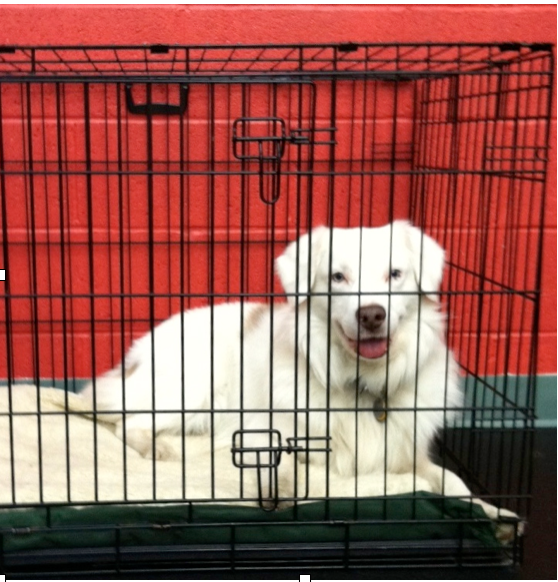A Home Away from Home:
Crate Training 101
The crate is probably one of the most important training tools that you will have for your dog. It is a necessity because it is the only portable means of confining your dog. Think of it like an RV is for humans, a home away from home.
Trained correctly, the crate can be a safe and even happy place from what can be a confusing world for a dog. When things get too chaotic (think Thanksgiving dinner for the entire family), your dog has a quiet place to rest. Crates make it easy to travel. You can set up the crate in a hotel room and instantly your dog feels at home. This is especially important for unplanned travel, like evacuations. Natural disasters never seem like they will happen to you but they are real and happen all the time. Your dog will be less stressed and easier to handle if he is used to a crate and can relax wherever you go. The crate should be big enough for the dog to lie down and stretch out, stand up without bumping his head and allow him to turn around easily.
Long term confinement for Veterinary care is infinitely less stressful if the dog has previously been conditioned to using a crate. Surgeries, injuries and sometimes illnesses require that the dog be confined at the hospital or home. If crating is not something the dog is used to, then they will be subjected to additional anxiety. Nevar’s first surgery had me a nervous wreck but when I brought him to the Vet, he went happily into the crate and was not stressed in the slightest. That made the rest of his stay much easier for him. Additionally, crating sometimes becomes logistically necessary for behavioral issues such as aggression to visitors.
Using the Crate
Mature dogs can be conditioned to using a crate, but it is easiest to condition a young puppy. Good breeders help to prepare the puppy for his life with you by doing the majority of the task. They give the puppy short periods of alone time in the crate. With dogs that have no previous history, or even a bad history, with the crate, you must proceed slowly.
Before training, the dog or pup should be tired from exercising and playing and should have had an opportunity to relieve himself. The dog should be placed into the crate with a Kong stuffed with yummies to lick, like peanut butter or yogurt. A tired hungry puppy or dog will almost always settle down and work on the Kong.
Be sure to stay close at first and then begin to walk around the room attending to chores. If the pup is fine with that, then it is ok to very briefly leave the room for a few seconds and then return. The pup will then likely fall asleep. It is ok to let her sleep for awhile, but after a bit, wake her up to go outside for a potty. If she wakes up, discovers you are gone and starts to bark, you will be faced with the dilemma of letting a barking dog out of the crate, which is a guaranteed way to ensure that she barks to be let out again in the future.
Dogs and puppies should be crated whenever you can’t supervise them. The crate is simply a means to keep them safe and out of trouble. They should always have an opportunity to relieve themselves before being put into a crate and should go in with a Kong or food puzzle to help occupy their brains. This positive association with the crate will pay off in the long run.
Going in the crate, should be something that is a non-event. It is not punishment, it is school. It should happen frequently and be of short duration. Sometimes the puppy will be alone and sometimes crated at your feet. Crating at night is a good opportunity for getting the pup used to being crated while you are around. They should be crated nearby so that they can see you and have the comfort of your presence. They are, after all, social creatures and now that they are in our human family, they will need to be near you.
How much is too much?
Crates help to shape good habits (i.e., learning to be alone while not chewing up the house!) but too much crating can have the opposite effect. A puppy that spends most of his day in the crate will not have the necessary opportunities to learn about the world. He will not be able to expend all that youthful energy and will come out of the crate even more rambunctious than when he went in. This can create a dangerous, vicious cycle. Puppies and dogs that have not had enough mental stimulation and physical exercise run the risk of developing behavioral problems ranging from destruction to aggression.
No dog or puppy should be crated for more than 4-6 hours at a time, depending on their age (the younger the dog, the shorter the crating period). Crate time should always be offset with an ample time to potty, drink, stretch their legs, learn new things and burn off steam by running and playing. Any more than 14-hours total crate time (including night time crating), is too much.
It is important to keep your dog used to a crate for the variety of reasons listed above. However, your dog should be able to eventually be trusted to be home alone uncrated. It is time to give this a try when you find that you no longer need to worry about him getting into trouble when you are home. Once you find that you can trust him without your eyes on him every second, you can consider some unsupervised freedom.

Leave a comment